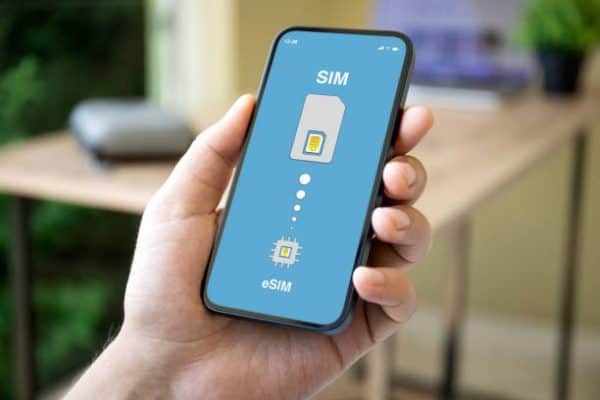Telcos must seriously consider obtaining eSIM cloud platform services and supporting eSIM devices and use cases as soon as possible. It’s their golden opportunity to expand their market share in the consumer and enterprise markets.
There’s excellent awareness of eSIM among consumers, with GSMA Intelligence predicting half of all smartphone connections using eSIM by 2028. Counterpoint Research agrees. The analyst firm projects that embedded and integrated SIM (eSIM and iSIM) smartphones will remain the primary driver of the hyper-growth in eSIM-equipped devices.
Additionally, the publication of the new eSIM Internet of Things (IoT) remote service provisioning (RSP) architecture and specifications further fuels the growth potential of the eSIM segment for telcos. The new specifications make it easy and relatively effortless for enterprises to roll out eSIM IoT solutions to satisfy their business requirements.
The increasing consumer and enterprise demand for eSIM, in turn, is driving eSIM adoption among original equipment manufacturers (OEMs). Since they have an assured market for eSIM-capable sensors, gadgets, telemeters, and other such devices, OEMs can confidently ramp up their production of eSIM IoT and cellular equipment.
The surging number of consumers and enterprises using eSIM and the booming production of eSIM devices are escalating demand for eSIM connectivity. Now is the perfect time for telcos to introduce eSIM solutions they can sell to consumers, enterprises, OEMs, and organisational buyers. The following are a few strategies telcos can adopt to unlock revenue opportunities from the spiralling adoption of eSIM.

1. Multi-Device Data Plans
Telcos can roll out multi-device data plans for consumers. The availability of eSIM-enabled smartwatches, laptops, tablets, and similar gadgets is increasing consumer demand for data. Telcos can capture this demand by creating multi-device data plans, allowing consumers to allocate their data to multiple eSIM devices.
Since they can allocate their data to multiple devices, subscribers are more willing to obtain higher data plans and use cellular data on more devices. This means higher data consumption overall, which translates to a higher average revenue per user.
2. Travel eSIM Plans
Telcos can also more easily capture a share of the transient data and cellular connectivity market – i.e., travellers and tourists. Armed with eSIM smartphones and gadgets, travellers can download eSIM profiles from network operators in their destination instead of activating roaming with their current providers. They can do this even before they leave home and activate the downloaded profile once they’ve arrived.
Therefore, telcos can provide eSIM services to tourists and travellers. They can market their travel eSIM packages aggressively online, paying for advertising or collaborating closely with:
- Airlines: They can advertise their eSIM plans on airline websites, airline apps and third-party flight-booking services, where people buy plane tickets. This way, people travelling to the country the telcos serve will see their travel eSIM packages and plans in a relevant context – while purchasing airline tickets and finalising their travel plans. This can induce these travellers to buy an eSIM package on the spot.
- Hotels: Telcos can alsoadvertise on hotel websites, online travel agencies (OTAs), and online aggregator sites. This way, people travelling to destinations telcos cover can already purchase their travel eSIM while booking hotel rooms.
Additionally, telcos can offer their travel eSIM at physical locations that travellers frequent: airports, seaports, bus stations, train stations, tourist attractions, and the conveyances themselves (e.g., aeroplanes, ferries, buses, trains).
Aside from travellers, telcos can also target students, soldiers, government employees, and other distinct demographics. The possibilities are endless.
3. Digital and Value-Added Services
Telcos can enable digital services like secure payment apps, productivity tools and cloud storage. This is especially relevant if they have segment-specific services like the travel eSIM above.
Telcos can also provide value-added services (VAS) that will enhance the user experience and boost retention (and, thus, profits); such VAS can include voice over LTE (VoLTE) and Rich Communication Services (RCS).
4. eSIM IoT Subscription Plans
Telcos can create data plans for enterprise IoT applications. They can deliver affordable and scalable eSIM connectivity services to enterprises, similar to how they provide subscription services to consumers. Telcos can work directly with enterprises or become the connectivity vendor for third-party solutions providers.
5. Managed IoT Services
Telcos can step up and provide managed IoT services to enterprises, manufacturers and organisational buyers (e.g., governments). They can:
- Provide eSIM orchestration services
- Design their clients’ private eSIM networks
- Incorporate 5G and other technologies into their eSIM connectivity plans
- Create the eSIM network infrastructure for clients
- Provide the software or systems clients need to deploy eSIM IoT and monitor their utilisation
- Provide clients with a platform to manage their data consumption
- Customise standard eSIM IoT solutions for the specific requirements of clients
- Enable smart network switching among eSIM IoT devices
- Develop custom applets to enhance productivity, function and efficiency
- Ensure IoT security
Instead of simply selling eSIM-accessible mobile data plans, telcos can take the lead in converting enterprises, manufacturers and organisations into eSIM IoT consumers.
For instance, by providing a plastic pipe manufacturing company with a bespoke IoT solution that relies on eSIM connectivity, they can win an enterprise account likely to remain with them for a long time. Providing managed services unlocks multiple revenue streams in the non-consumer market.
Opportunities in eSIM
More consumers, enterprises, manufacturers, and organisations are using eSIM, and more OEMs are innovating eSIM-capable devices. The result is a spiralling demand for eSIM connectivity and support.
Telcos can take advantage by taking the lead in providing eSIM solutions and services.
 Gearfuse Technology, Science, Culture & More
Gearfuse Technology, Science, Culture & More


